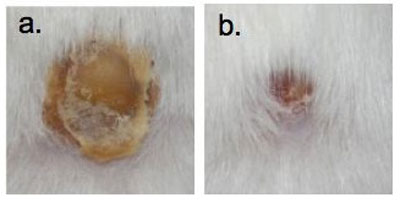| Posted: May 21, 2012 | |
Nitric oxide nanoparticles effectively treat candidal burn infections |
|
| (Nanowerk Spotlight) Candida albicans is a leading fungal cause of burn infections in hospital settings. The prevalence of invasive candidiasis in burn cases varies widely, but it accounts as high as 23% of severe infection with a mortality rate ranging from anywhere to 14% to 70%. | |
| In a recent pre-clinical study published in Frontiers Microbiology ("Nitric Oxide Releasing Nanoparticles for Treatment of Candida albicans Burn Infections"), a nitric oxide releasing nanoparticle platform (NO-np), which has previously been shown to be antibacterial to both gram positive and negative bacteria, as well as an accelerator of wound healing in excisional animal models, was found to be efficacious in clearing candidal burn infections in mice. | |
| "NO is known to have direct antifungal activity, can modulate host immune responses, and is a significant regulator of wound healing," says Dr Luis Martinez, Assistant Professor of Biomedical Science at Long Island University and senior author of the paper. "Here we extended our previously successful work using this NO releasing technology from bacterial pathogens and surgical wounds to a new organism, candida, as well as a new wound model, full thickness thermal burns, and found the NO-np to be highly effective." | |
 |
|
| NO nanoparticles accelerate thermal burn wound healing in setting of candida infection: Day 15 following full thickness thermal burn and infection with Candida albicans. Burn injuries of Balb/c mice untreated and treated with NO-np, day 0, 1, 5, 10, and 15. Five animals per group were used. These experiments were done twice with similar results. (Image: Dr. Adam Friedman, Albert Einstein College of Medicine) | |
| Using a murine burn model, NO-np demonstrated antifungal activity against C. albicans, most likely by arresting its growth and morphogenesis as was demonstrated in vitro. Moreover, the NO-np treated animals were found to have an accelerated rate of wound healing when compared to controls. The histological evaluation of the affected tissue revealed that NO-np treatment modified leukocyte infiltration, minimized the fungal burden, and reduced collagen degradation, thus providing potential mechanisms for the therapeutics' biological activity. | |
| We believe that it is of the utmost importance that innovative therapeutics to which this common yet highly pathogenic fungus is unlikely to evolve resistance be developed in order to limit the associated morbidity and mortality and ultimately improve our capacity to treat these infections. Nanotechnology represents a limitless avenue to both overcome medical quandaries, in this case, pathogen virulence and resistance, as well as effectively deliver highly labile agents such as nitric oxide. | |
| This study represents one of many pre-clinical investigations demonstrating the efficacy of the NO-np as a broad spectrum antimicrobial agent as well as wound healing accelerant. "It is very exciting to investigate new technologies that have clear clinical potential and translation, and will likely be used to combat skin and soft tissue infections in the near future," says Dr Martinez. | |
| In previous studies, covered by Nanowerk Spotlights, we have already shown that NO nanoparticles accelerate wound healing and are suitable for effective treatment of infections. | |
| By Dr. Adam Friedman, Director of Dermatologic Research and Associate Residency Program Director at the Unified Division of Dermatology of Montefiore Medical Center - Albert Einstein College of Medicine, and co-inventor of the NO platform | |
|
Become a Spotlight guest author! Join our large and growing group of guest contributors. Have you just published a scientific paper or have other exciting developments to share with the nanotechnology community? Here is how to publish on nanowerk.com. |
|
